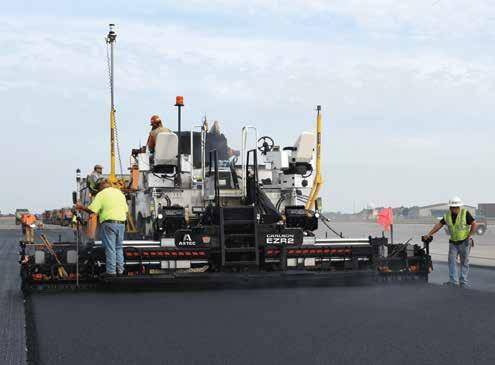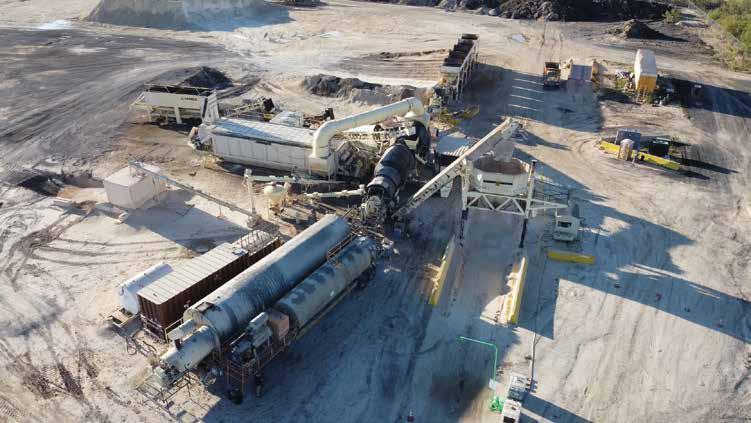
2 minute read
More quality in road construction
V Gele Roadscan
Technical Highlights
> Comprehensive measurement of asphalt temperature across entire pave width up to 10 m
> Simple operation and real-time display via the paver operator’s ErgoPlus 3 console
> Simple installation, no adjustments (plug & play)
> High-precision, permanently-integrated GPS receiver for recording exact position data
> Option of recording sub-base temperature before paving
> Can be combined with weather station to record external parameters affecting the project lab. We thought the increased heat would extend the Biopolymer but didn’t realize it would help to mature it. Therefore, we can add RAP to the mix and increase the performance grade of the biopolymer binder.”
He also noted the Multiple Stress Creep Recovery (MSCR) test improvements from the virgin binder to the extracted binder. While both designs passed flexibility tests for the virgin and extracted binders, the virgin lab results indicated that the E5A control sample may perform better than the experimental in the field.
“With RAP introduced to the mix, the control sample’s performance lowered, while the Biomag Section W10 sample showed improvement to better than that of the control, which could indicate a better resistance to rutting,” Hohmann added.
A series of standard mixture performance tests were also performed on the samples. These included Dynamic Modulus, Hamburg Wheel Tracking, Illinois Flexibility Test (I-FIT), Energy Ratio, Indirect Tensile Asphalt Cracking (IDEAL-CT), High Temperature Indirect Tensile (HT-IDT), Cantabro Percentage Loss, and Disc Shaped Compaction Tension (DCT) tests. All results showed similar or only minor statistical performance differences between the control and experimental mixtures with no sample failing the acceptable standards.
Excelling In The Field
Based on the lab results, Tran noted, “We expected both mixtures to perform very well at the Test Track, and we had no surprises.”
Nelson added, “We are now into 13 million equivalent single axle loads (ESALs) with less cracking noticed in the experimental Section W10.”
Both E5A and W10 surface mixes were paved at the NCAT Test Track in 2018 with the plan of conducting two three-year testing cycles. The first cycle finished in 2021 after logging 10 million ESALs, equivalent to 15-20 years of traffic. At this point, both the control SBS-modified polymer and experimental EBS biopolymer sections were evaluated for rutting, cracking, roughness and macrotexture.


Passing the test with minimal rutting, E5A showed only 2.4 millimeters (0.094 inch) of rutting and W10 had 4.7 millimeters (0.185 inch), well below the threshold commonly considered failing of 12.5 millimeters (0.5 inch). “These results are impressive, as you want some level of rutting of the mix. Otherwise, it will be too stiff, which can result in cracking,” Powell said. “The experimental biopolymer binder asphalt is a healthy mix.”
Both mixes offered excellent cracking performance as well. The first crack in the control section wasn’t observed until mid-November 2020, and there was no observed cracking in the Biomag surface by the end of the trafficking cycle Feb. 28, 2021. Additionally, roughness observations during the cycle using the International Roughness Index (IRI) showed similar changes over time for both the control and experimental surfaces, with Section W10 scoring a 102-inches per mile roughness and Section E5A 112-inches per mile.
The final field performance was surface macrotexture. While Section W10 showed a higher macrotexture at the cycle’s beginning, the change for the two sections was virtually identical at the end.
The second 10 million EASLs cycle is scheduled for completion in 2024. Both Powell and Hohmann offered some thoughts about the Biomag W10 test results and the potential for optimizing the design. “As mentioned, the original goal of W10 design was to match the control mix with 20% RAP added,” Powell said. “These test results indicate that the biopolymer produces a healthy mix that could be optimized for RAP content.”
Hohmann agreed and added, “A producer reaps significant ROI benefits at RAP content of more than 25%, as this saves on virgin binder and aggregate. These results give us confidence that we can achieve this with Biomag Hot Mix while offering cost, performance and sustainability advantages for the producer.”






